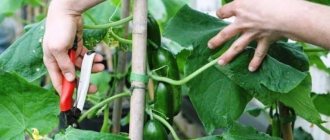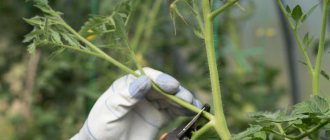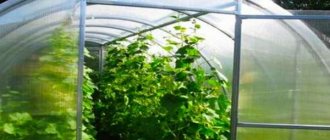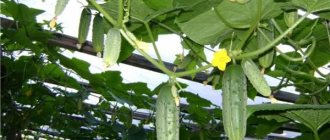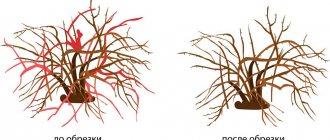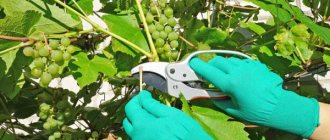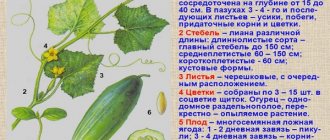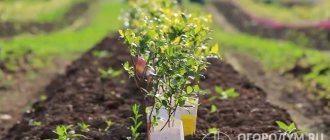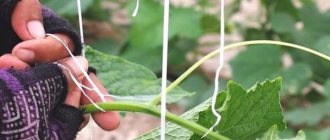Author's rating
Author of the article
Yakov Pavlovich
Professor, Head of the Department of Vegetable Growing
Articles written
153
Pruning cucumbers in a greenhouse or open ground, the pattern of which you need to know, helps increase the number of fruits. At the same time, their taste improves. Maintenance is made easier. There are two types of pruning. They are used for different purposes. By following the rules for caring for cucumbers, gardeners grow a large amount of healthy crops.
Purposes of pruning cucumbers
Pruning has at least five purposes. Why do this in a greenhouse or open ground:
- The plant will retain its strength as it begins to mature.
- The cucumbers will have the correct shape.
- The resulting nutrition will be directed to the development of the first flowers, and not the side branches.
- Reduce the risk of disease. The bushes will not be so large, which is comfortable for a summer resident.
- The lower branches will be removed, making maintenance easier.
Expert opinion
Stanislav Pavlovich
Gardener with 17 years of experience and our expert
Ask a Question
Important! The cotyledon leaves cannot be removed. Because of this, the plant may die or produce little fruit.
When pruning, only the excess is trimmed. Otherwise, the amount of harvest will not increase, but, on the contrary, will decrease.
Methods for tying bushes before shaping
A garter is the securing and guiding of a cucumber vine along a guide. In a tied plant, it is easy to identify the main stem and lateral shoots.
Cucumbers are gartered when 4-6 leaves form on the vine, and the plant itself grows more than 30 cm long. A special structure is built for gartering, which will help the bush form and free up space in the garden bed.
Prepare materials for making supports:
- two-meter posts made of wood or metal;
- twine or cord;
- plastic mesh;
- hooks for fastening;
- fixing pegs;
- strips of soft fabric (cotton, knitwear) 3-4 cm wide;
- tools – hammer and pliers;
- nails.
It is not recommended to use thin wire for gartering - it can injure the plants.
There are several methods for gartering cucumbers - let's look at each in more detail.
Vertical
This method is convenient because each plant will have an individual support along which it can climb:
Inside the greenhouse, along the edges of the bed, a U-shaped structure 2 m high is placed - if the bed is long, you can put an additional support in the middle of the P. One end of a rope or twine is attached to the upper horizontal bar, the number of which depends on the number of cucumber seedlings. The second end is lowered down, pulled and secured in the ground with pegs or pins next to the bush. The cucumber stem is carefully wrapped around the support, directing it clockwise. The plant is carefully secured with strips of fabric.
Horizontal
This method is used in open ground or low greenhouses:
- On both sides of the beds, supports 1.5-2 m high are dug in - there are two pillars for each row of cucumbers.
- Between them, at a distance of about 30 cm from the ground, stretch the first row of cord or twine.
- Parallel to the first, several rows of cord are pulled at the same distance (25-30 cm) from each other to the very top.
- Young shoots are carefully directed to the lower tier of the structure; they can be secured with strips of soft fabric so that they do not fall; then they themselves will begin to crawl along the rows of the support and form.
The disadvantage of this method is that as soon as the cucumber vine reaches the upper level, it will no longer be able to continue to rise further and will begin to hang down, shading the lower part of the plant and interfering with the care of the bush.
Mesh
The stores offer a large selection of nets for weaving plants - they are easy to install, have large cells and are made of durable, non-rotting materials:
- Two supports up to 2.5 m high are dug in on both sides of the bed.
- The mesh is stretched and firmly secured between them.
- The bushes are directed onto the net and, if necessary, secured with strips of fabric.
- The cucumber vine itself is woven into the mesh and formed.
When gartering, the lashes are tied loosely, without tension, so as not to tear the plant out of the ground. The top is left free, otherwise the plant will begin to turn yellow and wither.
Advantages and disadvantages
Before you start pruning, weigh the advantages and disadvantages.
Positive sides:
- After removing unnecessary leaves, the resulting forces of the bush will be directed to the ripening of cucumbers. This will increase the quality and quantity of the fruit.
- The plant will become stronger. This means that the risk of infection will decrease. This will save the crop from destruction.
- It will become lighter in the greenhouse or garden bed. This is an important moment in ripening.
- It will be easier to care for the bushes and pick cucumbers.
Among the disadvantages of such care, gardeners note only that the leaves can be trimmed incorrectly. And this, on the contrary, will destroy the bush. Therefore, you need to carefully study the theory.
Care after pruning
Immediately after pruning, the plants are slightly weakened, which means they need to be fed. First comes the calcium supplement, then the potassium supplement. Cucumbers also need nitrogen and phosphorus. Nitrogen is needed to keep the leaves large and green. Large leaves will better feed the greens.
Inspect the bush; if the leaves are large and bright green, then there is no need to feed it with nitrogen. Nitrogen is required for small, pale leaves.
It is important to always remove old leaves. If the leaf is limp or yellow, then carefully cut it off, because it still requires nutrition. In addition, it can “warm up” pests that will move to the entire bush.
How to feed during fruiting? If manure is applied in the fall: 10 kg per 1 square, then in the summer much less mineral fertilizers will be required than without manure.
If the leaves on the borage are small and underdeveloped, then take 10 g of calcemite and 10 g of ammonium nitrate per bucket of water. Once a week, it is recommended to pour 0.5 liters of fertilizer under each bush.
To have more cucumbers, once a week you should add 1 g of potassium and 1 g of magnesium per bush. Spray with the multicomplex once every 10 days, diluting it according to the instructions.
To produce more ovaries, you should spray with Plantofol-ovary. This drug is used according to formulas, so before purchasing you need to look at the note on the package. This preparation can be sprayed 3-4 times per season, wetting the leaves well.
Types of pruning
There are two types of pruning. They are carried out for different purposes depending on the condition of the bushes. The general purpose is to improve fruiting. It affects the quality and quantity of cucumbers. It is used if the beds are in good condition.
The brightening type is used when plants are affected by a fungal or other disease. In this case, pruning helps to direct all efforts towards restoration.
Important! Lightening pruning is usually carried out on rainy days.
It is necessary to consider each of the types and determine the decisive principles in order to eliminate errors and crop loss.
General
General pruning is carried out if the cucumbers are self-pollinating. Most varieties produce a large number of fruits. Formation occurs on a strong stem. But you can also leave cucumbers on the side branches.
See also: How can you feed cucumbers during flowering and fruiting?
You need to trim the inflorescences, barren flowers, and shoots that grow from the side from below. As well as leaves that grow downward and appear limp. Next, 3 sprouts are left above. It is the hybrid varieties that require such care. This is explained by the fact that cucumbers ripen on the stem.
Important! The bush needs to be mentally divided into several parts in order to cut off shoots that are superfluous on the plant.
Brightening
Lightening pruning is carried out if the plants are damaged by bacteria, virus or weakened. Side shoots are removed. All leaves that provide shade and are an obstacle to the sun are removed. Leaves that turn yellow, droop and wither are also cut off. Several ovaries are left. About 2-3.
Gardeners do not always remove side leaves. Sometimes they leave a few pieces. The main thing is that they are healthy. These parts point downwards. After this, vertical growth stops. All energy goes into filling the fruits and their ripening. If there are no strong leaves, you need to remove them.
Basic rules for pruning leaves
Any pruning injures the plant, although if you leave everything as it is, the shoots will begin to fatten, gaining green mass instead of fruits. Therefore, the main rule is not to go to extremes. Those. carry out total pruning of a significant part of the leaves and at the same time do not let the vines grow until they intertwine and thicken the plantings.
Many years of experience of summer residents shows that, regardless of the variety, when pruning it is worth following several universal rules:
- In most cases, the foliage is removed “to zero”, without even leaving a stump. Large foliage can simply be cut in half.
- In order not to injure the plant, it is better to trim with pruning shears, the blades of which are pre-treated in a 1% solution of potassium permanganate (light pink liquid) or other antiseptic.
- The sections must be sprinkled with crushed charcoal or activated carbon powder (can be purchased at the pharmacy).
- It is advisable to remove no more than 3 leaves at a time. Although if they are sick, you will have to carry out total pruning to prevent further spread of the infection and contamination of neighboring plants.
- It is advisable to carry out the pruning procedure on a sunny morning.
- If a cucumber variety is pollinated by insects, it is better to grow it in one stem, and it is important to remove all the leaves covering the inflorescences - otherwise the bees may not pollinate them.
- Through the cuts, the plant will inevitably lose moisture, so in the evening it is better to water the cucumbers with warm, settled water.
Leaves and shoots should be trimmed with pruning shears, not by hand.
Thus, it is possible and necessary to trim the leaves of cucumbers. This is a useful procedure that is absolutely necessary for thinning vines, forming a bush and removing affected foliage. Also, cutting can significantly increase productivity, which has been tested by experienced gardeners.
When should the procedure be performed?
It is impossible to determine exactly when to trim the vines. The timing depends on the time of planting in the ground and the growth rate. As well as the climatic conditions of a particular region and place of germination. The main regulator of pruning timing is the growth and development of leaves, stems, and shoots.
First, the leaves and stepsons are removed when their length does not exceed 5 cm. The length of the lash should be 50 cm. The top is shortened when the end is 1 meter above the ground. Stepchildren are pruned when up to 5 nodes appear.
Important! It is necessary to constantly monitor the condition of the plants so as not to miss individual pruning dates.
Basic principles of pruning
How to properly trim cucumbers in a greenhouse? This is the formation of bushes, their formation according to the model required for their good growth and development. To do this correctly, you need:
- know how different varieties are pollinated;
- It’s good to know what kind of cucumbers grow in the greenhouse. The pruning will depend on this (bush or vine).
General rules applicable to all types and varieties
- greenhouse cucumbers and pruning are related concepts;
- pruning should be done no earlier than 10 days after planting, after tying up the bushes;
- do not perform pruning with a dirty tool, as this can cause infection;
- Stumps should not be left;
- You should always remove ovaries and flowers from the bottom of the bush. You need to start from the moment the young bush acquires 5 leaves;
- Unfortunately, the matter will not be limited to just pruning. As the stem grows upward, you will need to carry out this procedure;
- no need to tear off the top of the bush with your hands, use a sharp tool;
- Pruning activities should be carried out in the morning so that in the evening the wounds heal and the bushes do not get infected;
- Dead leaves on old bushes should be removed regularly. Yellow and brown, they can disrupt the movement of juices in the stem;
- Keep in mind that the upper parts of the bushes need a lot of light, so at the top the lashes are not directed along the crossbars, but thrown over them;
- sunlight and regular watering do their job: the foliage grows constantly. Inspection, pruning and garter should be constant;
- varieties pollinated by bees should grow in one stem;
- How do you know if your actions are correct? Look at the formed bush. It should be shaped like an inverted isosceles triangle.
Timing for the formation of cucumber bushes
It is very important to observe the timing of pinching bushes, otherwise they may waste energy on extra shoots and form few ovaries and flowers.
- You can start shaping as soon as the stepsons have already grown to 5 cm. There is no need to worry, this will not harm the bush.
- Don’t be lazy, immediately after planting the seedlings, tie the main stem of the bush to the top crossbar with a rope or twine.
- Do not allow the shoots to harden. It's better to cut them off in advance.
- Has the top grown very long already? Great! Make a loop out of it and tie it to the trellis above.
- The side shoots need to be pinched taking into account the size of your greenhouse.
- You can pick up to 5 leaves from each node. A smaller volume is not effective, and a larger volume can harm the plant.
What tools are needed
There are several types of instruments used for circumcision, which can be useful depending on the situation. Damaged vines should be removed with good pruning shears. It is recommended to take a long tool. To remove flowers, you need to take garden shears. They will also be needed for maintaining the vines and shoots, and for thinning. Thick stems lend themselves to loppers. Young stepsons can be removed manually.
You need to very carefully remove excess with your own hands. All tools must be sharpened and prepared for work. It is desirable that they fit well in the hand. Do not damage the bush too much.
Garter of cucumbers to a trellis
In a greenhouse, cucumbers definitely need support. This way the usable area will be used rationally, and the plants will receive more lighting.
Trellis are installed as support before planting seedlings:
- A vertical trellis is a wire stretched horizontally at a height of 2 to 2.2 m along the entire row of cucumbers, from which ropes are lowered down to each bush;
- Horizontal support - 3-5 levels of wire are pulled horizontally along the row in increments of 40-50 cm;
- V-shaped trellis - mounted according to the vertical principle, but two ropes are lowered from the upper support to the bushes, placing them on different sides;
- Cucumber mesh is a nylon trellis with large cells, which is stretched along a row onto supports.
Seedlings are planted at a distance of 35-40 cm from each other so that there is enough space for the bushes to grow and care for them. This is also necessary so that pruning the leaves of cucumbers is not difficult. 7-10 days after planting, they begin tying the cucumbers to the trellis, after watering them.
When gartering, fragile seedlings are easily pulled out of the ground, so you need to act very carefully. A loop of fastening rope is placed on the bush under the second leaf. It should not be tight and have a gap to thicken the stem. The second end of the rope is attached to the trellis so that its tension is free. As they grow, the direction of the lashes is adjusted by wrapping them around with a fastening rope.
How to properly prune cucumbers for a good harvest
It is important to trim cucumbers correctly. Accuracy and a serious approach affect the quality and quantity of the harvest. Caring for greenhouse beds and open beds is different. It is necessary to take into account the peculiarities of pruning in different places of germination, since the conditions in this case are very different.
In the open ground
Removal of sheets occurs in different ways, depending on what shape it is decided to give. How to prune in open ground:
- Retreat from the ground exactly to 4 leaves on the stem. In this interval, remove all the stepsons that exist. It is important at this time not to damage the plant and do everything carefully.
- Leave 1 ovary and the same number of leaves between the 5th and 8th leaves.
- Further along the stem, leave 2 ovaries and the same number of leaves. Everything else should be removed carefully with tools.
- After the 10th leaf, cut off the side shoots. Enough 3 leaves and ovaries.
See also: Fruitful and popular varieties of cucumbers for polycarbonate greenhouses
If you pick off leaves and sprouts in this way, the plant will have enough light. This will promote good growth and ripening.
In the greenhouse
Tearing off leaves in a greenhouse is also easy. A similar principle is followed. How to trim:
- Remove side shoots that grow up to 4 leaves.
- Leave 1 stepson after the 7th leaf. Remove the rest.
- After 10, remove the lateral shoots. There should be 3 leaves with ovaries left.
- Next, leave 3 leaves and the same number of ovaries.
- Next, remove side shoots that may reappear.
During the entire period of growth and fruiting, several prunings occur. With each formation, it is important to support the plant and provide support for it, tie it up. All actions must be performed extremely carefully.
Basic principles of pruning in a greenhouse
Seedlings in a greenhouse quickly increase their vegetative mass - stems, leaves, inflorescences and ovaries. Nutrients are evenly distributed throughout the vine - cutting off excess shoots and leaves contributes to better nutrition of the ovaries.
Experienced gardeners recommend adhering to general principles when pruning greenhouse cucumbers:
- The bush is formed no earlier than a week and a half after planting.
- The formation of bushes begins with a garter.
- Pruning is carried out only with sharp sterilized instruments (boil for 5-10 minutes) - breaking off the stepsons with your hands can damage the plant.
- The shoots are trimmed close to the stem, without leaving any protruding “stumps”.
- Pruning is done regularly as the bush grows - at least once a week.
- The procedure is carried out in the morning so that by evening the “wounds” heal and the plant does not catch an infection.
- The air temperature is at least 20°C.
During any manipulations with the plant, carefully handle the central stem - if it is damaged, the plant dies.
Aftercare for cucumbers
Every stage in growing is important. Immediately after pruning, additional nutrition should be provided to plants that may be weakened. To properly create a “diet” you need to monitor the condition and reaction of the bushes to the application of fertilizers.
Cucumbers must receive sufficient amounts of nitrogen, as well as potassium and phosphorus. It is important to ensure normal watering. When barren flowers appear, it is reduced. In case of cucumber disease, you need to take care of special fertilizers depending on the nature of the disease. Only in this case will the remaining parts of the plant receive a sufficient amount of microelements.
Important! You should take warm and clean water without impurities.
Living water for cucumbers
For good ovary of cucumbers, you can use hydrogen peroxide. The chemical composition of peroxide is similar to melt and rain water. Therefore, a solution with peroxide helps cucumbers grow and develop well. Even 2-3 hours after spraying, you can notice how the leaves become rich green and juicy.
Thanks to hydrogen peroxide, the soil is saturated with oxygen, the absorption of nutrients improves, and productivity increases by 25%. Fertilize every 7-10 days. You should spray the stems, leaves, and always on the back side of the foliage. It is better to do the work in the evening.
How to feed at the root:
- First you need to moisten the soil.
- Then carry out loosening.
- The life-giving liquid must be poured into the grooves, which are located between the rows of cucumbers, at a distance of 7-8 cm from the stem.
- Watering or spraying is carried out with a solution (1 tbsp per 1 liter of water).
If plants are wilting or have weak immunity, then a peroxide solution will help them recover in a short time. Adult bushes can be treated once a week (1.5 tbsp per 1 liter of water).
To get an excellent harvest of cucumbers, you need to spray once every 10 days with a solution: 9 liters of water, 1 tbsp. l. hydrogen peroxide, 1 liter of milk and 40 drops of iodine.
Complex feeding saturates cucumbers with potassium, calcium, phosphorus, manganese, and iron. In a word, everything that a crop requires for good fruiting.
When and how to pick leaves from cucumber seedlings
It is not enough to remove only the shoots. In addition, you need to periodically remove adult leaves. This is done throughout the entire period of growth and fruiting, regardless of the pruning process. If the leaf is flaccid, slightly yellow, it is carefully removed. Not only does it still require nutrition, but it can also be affected by pests that will spread to the entire plant.
Is it necessary to trim the leaves of cucumbers in a greenhouse and why?
Pruning leaves and forming bushes is an expedient and effective procedure for improving the quality of the crop. With uncontrolled growth of the plant, many empty flowers (male inflorescences) are formed, the cucumber vine begins to branch, making care difficult.
How to form cucumbers in a greenhouse into one stem
Please note that varieties of cucumbers have already been bred with a bouquet or, as they are also called, fascicle ovary - several cucumbers are formed in each leaf axil. For such varieties, a different formation is needed.
At the initial stage, the formation is similar to conventional varieties - in the axils of 3-5 leaves, remove all ovaries and shoots.
Next, the plant must be kept in one stem, and all side shoots must be removed.
How to prune cucumbers in open ground
Pruning cucumbers is a very simple task.
How to trim cucumbers? The formation of a cucumber bush when growing this vegetable crop in open ground is necessary to obtain an earlier harvest.
In addition, for some varieties and hybrids, pruning is recommended for certain biological characteristics. Usually it is used to regulate the number of male and female flowers.
Most often, late-ripening varieties are pruned. They are characterized by the presence of a larger number of male flowers. Therefore, thanks to the formation of the bush, productivity increases significantly.
Trimming cucumbers in an open garden bed:
Pruning is done before flowering. The formation of the bush is carried out by pinching. In this case, the uppermost section of the main stem (growth point) is removed by 0.5 cm. If the procedure was carried out correctly, after 6-7 days new shoots will form in the leaf axils. Subsequently, much more ovary is formed on them than on the main shoot.
The first pinching is carried out at the level of 5-6 leaves. This is the so-called blinding procedure. Next, until the main stem reaches a height of 1.0 m, pinching is carried out on one leaf and fruit.
On the next 30 cm, the lateral stepsons above the 2-3 leaves are pinched. When the main shoot grows to 130 cm, it is tied at point 110 to the support. After pinching the edge, the father-in-law removes the top.
Side shoots are pinched over 3-4 leaves. By this time they should have shoots of the second order and be at least 40 cm in length. Only under such conditions is the productivity of the cucumber bush preserved and enhanced.
Bush varieties of cucumbers do not always require pruning. This procedure must be carried out if 7-8 leaves have already formed on the young shoot, but there are no side leaves yet. In this case, it is necessary to pinch the top of the main shoot. There is no need to trim the side shoots in the future.
For some bush varieties, pruning is required. It is carried out according to the following scheme: on the main stem, the growth point after the fifth leaf is removed. On new stepsons, the growth point is destroyed behind the second leaf.
When growing early ripening varieties, as well as hybrids with female flowering, bushes are not pinched. This is due to the high yield potential.
Common mistakes gardeners make
Cucumbers have been grown for a long time, but gardeners continue to make mistakes in caring for them:
- Ventilation of the greenhouse. This should be done if the temperature has risen to 30 degrees. It is unacceptable to open all windows and doors at once, creating a draft.
- Abundance of moisture and uneven watering. Gardeners often water cucumbers generously. Although the culture loves moisture, it is not in such quantity. Moreover, uneven watering first depletes the plant with drought, and then leads to loss of ovaries due to excess moisture. Seedlings should be watered once a week, using 10 liters of water per 1 m2 of soil.
- No crop rotation. Some farmers are inclined to think that if this year brought a good harvest of cucumbers, then next year they need to be planted in the same place. It is not right. Crop rotation helps plants obtain nutrients left behind by their predecessors. It should be remembered that crop rotation involves alternating different crops on a piece of land.
Attention: cucumbers, pumpkin, zucchini and squash are identical to each other. You can swap them with root crops or berries. Attentive attitude to planting and a genuine interest in knowledge of agricultural technology will help over time to achieve perfection in growing garden crops
Attentive attention to planting and a genuine interest in knowledge of agricultural technology will help over time to achieve perfection in growing garden crops.
Previous CucumbersHow to plant cucumbers in different patterns in a greenhouse Next CucumbersHow to properly grow and care for cucumbers in open ground
What leaves need to be removed from cucumbers for a good harvest?
If the soil is rich in nitrogen, the cucumber foliage will be extremely lush. Such a plant is poorly ventilated, which means conditions are created for the development of gray rot and other types of bacterial infection. Therefore, some of the foliage needs to be removed.
First, remove all diseased and damaged leaves, and then those located in those places that are very thick. Do not remove the cotyledon leaves - they will fall off on their own when the plant no longer needs them, as well as strong, healthy leaves.
Methods for pre-tying cucumbers before forming in a greenhouse (table)
The first step is to decide which garter method to choose. The process of forming cucumber bushes will depend on it. There are several basic methods that are most often used indoors.
| Garter method | Step by step procedure |
| Vertical | 1. Fold a piece of twine in half. |
| 2. Fix vertically on the open side or top crossbar of the frame. | |
| 3. Attach the lower end in the form of a loop to the plant under the second or third leaf without strong tension. | |
| Vertical on pegs | 1. Hammer the prepared pegs into the ground next to the bush (you can do this before planting so as not to damage the root system). |
| 2. Tie the twine to the peg, secure the upper end to the crossbar of the frame from above without tension. | |
| Horizontal | 1. Fix the main stem on the first row of wire located horizontally so that in the future the leaves do not come into contact with the soil. |
| (for low greenhouses) | 2. As it grows, wrap the lashes around the wire. |
| 3. Use additional pieces of cord to help the shoots reach the row above. | |
| Mixed | 1. Direct the shoots, which will themselves be located on the cells. |
| (on a trellis or polymer mesh with large cells) | 2. Monitor the direction vector. |
| 2. When the mesh is inclined (in the form of a tent), guide the stems, ensuring maximum access to light and air. |
Parthenocarpics (they are the ones most suitable for a greenhouse) need access to the maximum amount of light. Being self-pollinating varieties, they do without the presence of insects and bees. It is convenient to grow bushes on a plastic mesh or other type of trellis.
Why is it necessary to prune a cucumber bush?
Cucumbers are not difficult to grow. Almost always this crop produces a good harvest. But in order for the cucumbers to be of high quality and the same shape, it is advisable to form a cucumber bush by trimming leaves and vines.
After pruning cucumbers, the following fruits may appear (photo)
By carrying out correct and regular pruning of the above-ground parts of cucumbers, the following results can be achieved:
- Improved Productivity
- Enlargement of the ovary
- Improving fruit quality
- Reducing the risk of fungal infections
- Preventing harmful insects
With proper formation of the bush, the green mass of the plant is significantly reduced. This allows you to direct all your efforts to the formation of fruits. The consumption of nutrients for the maintenance and growth of vegetative mass is also reduced.
When choosing a pruning method, it is necessary to take into account the plant variety, growing season and harvest period. In addition, special attention is paid to the method of pollination of the cucumber bush.
Basic principles of pruning cucumbers:
- This procedure must be carried out early in the morning.
- Only sharp garden shears are used
- It is recommended to pre-treat garden tools with a disinfectant
- It is strictly forbidden to break off shoots
- In established bushes, the lower brown leaves must be removed every week.
- It is necessary to adjust the direction of the lashes on young bushes
- When growing varieties pollinated by insects, the bush is formed into a single stem
- When the growth of bushes slows down, it is necessary to carry out lightening pruning
- Also, all damaged or discolored leaves should be removed regularly from young and adult bushes.
Often a large number of barren flowers appear on fairly well-developed bushes. You should not completely remove such shoots right away.
You can try feeding the bush with fertilizers and changing the watering system. If this does not bring positive changes, then the shoots can be cut out.
Expert opinion
Yulia Yurievna
I have a large garden and vegetable garden, several greenhouses. I love modern methods of cultivating plants and mulching the soil, and I share my experience.
Ask a Question
Before radical pruning of cucumbers, it is really worth trying to change the care. To ensure fruiting, fertilizing must be done with products that contain large amounts of potassium, phosphorus and boron. Nitrogen-containing products should not be used, as this will only aggravate the situation and provoke the growth of green mass to the detriment of the harvest. We recommend using foliar fertilizers, because with their help cucumber bushes absorb nutrients much faster. To provide plants with phosphorus, you can dissolve 30-35 grams of superphosphate in a ten-liter bucket of water. Since superphosphates are diluted slowly, it is better to pour the measured dry mass into a small container about a day before use and fill it with hot water, and immediately before use, pour the resulting mixture into the rest of the liquid. To feed the bush with potassium and boron per 10 liters of water you need to take 2 grams of boric acid and 7-8 grams of potassium sulfate. We recommend that you first test the described product on a small area, since potassium products sometimes cause burns on sensitive crowns.
These pruning principles are followed for any type of cucumber cultivation.
When forming a cucumber bush using pruning, do not forget about tying up the shoots. This will prevent infection from entering the cutting area from the soil. On tied shoots, the wounds remain clean and dry quickly.
